Highly Permeable Ultrafiltration Membranes Based on Polyphenylene Sulfone with Cardo Fragments
Abstract
1. Introduction
2. Materials and Methods
2.1. Materials
2.2. Gel Permeation Chromatography (GPC) Method
2.3. Determination of Coagulation Values
2.4. Preparation of Dense Polymer Films
2.5. Investigation of Mechanical Properties of Dense Polymer Films
2.6. Preparation of Casting Solutions
2.7. Determination of Dynamic Viscosity of Casting Solutions
2.8. Kinetics of Coagulation of Casting Solutions
2.9. Preparation of Flat-Sheet Asymmetric Membranes
2.10. Investigation of Transport and Separation Properties of Flat-Sheet Asymmetric Membranes
2.11. Scanning Electron Microscopy (SEM) Method
3. Results
3.1. Properties of Polyphenylene Sulfone Cardo Copolymers
3.1.1. Molecular Weight Characteristics of Synthesized Polymers
3.1.2. Solubility of Cardo Copolymers in Aprotic Solvents
3.1.3. Mechanical Properties of Flat-Sheet Dense Films
3.2. Investigation of Properties of Casting Solutions Based on PPSU and Cardo Copolymers
3.3. Investigation of Morphology, Transport, and Separation Properties of Flat-Sheet Asymmetric Membranes Based on PPSU and Cardo Copolymers
4. Conclusions
Author Contributions
Funding
Institutional Review Board Statement
Data Availability Statement
Acknowledgments
Conflicts of Interest
References
- UNESCO. The United Nations World Water Development Report 2023: Partnerships and Cooperation for Water. Available online: https://www.unesco.org/reports/wwdr/2023/en/download (accessed on 8 October 2023).
- Qadri, R.; Muneeb, A.F. Freshwater Pollution: Effects on Aquatic Life and Human Health. In Fresh Water Pollution Dynamics and Remediation; Springer: Berlin/Heidelberg, Germany, 2020; pp. 15–26. [Google Scholar] [CrossRef]
- Mazhar, M.A.; Khan, N.A.; Ahmed, S.; Khan, A.H.; Hussain, A.; Rahisuddin; Changani, F.; Yousefi, M.; Ahmadi, S.; Vambol, V. Chlorination disinfection by-products in municipal drinking water—A review. J. Clean. Prod. 2020, 273, 123159. [Google Scholar] [CrossRef]
- Goswami, K.P.; Pugazhenthi, G. Credibility of polymeric and ceramic membrane filtration in the removal of bacteria and virus from water: A review. J. Environ. Manag. 2020, 268, 110583. [Google Scholar] [CrossRef] [PubMed]
- Lesimple, A.; Jasim, S.Y.; Johnson, D.J.; Hilal, N. The role of wastewater treatment plants as tools for SARS-CoV-2 early detection and removal. J. Water Process Eng. 2020, 38, 101544. [Google Scholar] [CrossRef]
- Bodzek, M.; Konieczny, K.; Rajca, M. Membranes in water and wastewater disinfection. Arch. Environ. Prot. 2019, 45, 3–18. [Google Scholar] [CrossRef]
- Fiksdal, L.; Leiknes, T. The effect of coagulation with MF/UF membrane filtration for the removal of virus in drinking water. J. Membr. Sci. 2006, 279, 364–371. [Google Scholar] [CrossRef]
- Zodrow, K.; Brunet, L.; Mahendra, S.; Li, D.; Zhang, A.; Li, Q.; Alvarez, P.J. Polysulfone ultrafiltration membranes impregnated with silver nanoparticles show improved biofouling resistance and virus removal. Water Res. 2009, 43, 715–723. [Google Scholar] [CrossRef] [PubMed]
- Koh, E.; Cho, N.; Park, H.M.; Lee, Y.T. Surface modification of PVDF hollow fiber ultrafiltration membranes for biopharmaceutical products, virus, and bacterial phage removal technology. J. Water Process Eng. 2023, 55, 104094. [Google Scholar] [CrossRef]
- Ultrason® E, S, P. Product Brochure—Plastics & Rubber. Available online: https://www.basf.com/cn/documents/en/chinaplas/UltrasonESPproductbrochureEN.pdf (accessed on 10 October 2023).
- Anokhina, T.; Raeva, A.; Sokolov, S.; Storchun, A.; Filatova, M.; Zhansitov, A.; Kurdanova, Z.; Shakhmurzova, K.; Khashirova, S.; Borisov, I. Effect of Composition and Viscosity of Spinning Solution on Ultrafiltration Properties of Polyphenylene Sulfone Hollow-Fiber Membranes. Membranes 2022, 12, 1113. [Google Scholar] [CrossRef]
- Liu, Y.; Yue, X.; Zhang, S.; Ren, J.; Yang, L.; Wang, Q.; Wang, G. Synthesis of sulfonated polyphenylsulfone as candidates for antifouling ultrafiltration membrane. Sep. Purif. Technol. 2012, 98, 298–307. [Google Scholar] [CrossRef]
- Feng, Y.; Han, G.; Chung, T.S.; Weber, M.; Widjojo, N.; Maletzko, C. Effects of polyethylene glycol on membrane formation and properties of hydrophilic sulfonated polyphenylenesulfone (sPPSU) membranes. J. Membr. Sci. 2017, 531, 27–35. [Google Scholar] [CrossRef]
- Zhang, J.J.; Bu, H.; Chen, S.W.; Bi, H.P.; Hu, Z.X.; Wang, L.J. Preparation and Characterizations of novel ultrafiltration membranes from sulfonated poly (arylene ether sulfone) s. Adv. Mater. Res. 2013, 664, 780–784. [Google Scholar] [CrossRef]
- Feng, Y.; Han, G.; Zhang, L.; Chen, S.B.; Chung, T.S.; Weber, M.; Staudt, C.; Maletzko, C. Rheology and phase inversion behavior of polyphenylenesulfone (PPSU) and sulfonated PPSU for membrane formation. Polymer 2016, 99, 72–82. [Google Scholar] [CrossRef]
- Zhong, P.; Fu, X.; Chung, T.S.; Weber, M.; Maletzko, C. Development of thin-film composite forward osmosis hollow fiber membranes using direct sulfonated polyphenylenesulfone (sPPSU) as membrane substrates. Environ. Sci. Technol. 2013, 47, 7430–7436. [Google Scholar] [CrossRef] [PubMed]
- Li, P.; Lim, S.S.; Neo, J.G.; Ong, R.C.; Weber, M.; Staudt, C.; Widjojo, N.; Maletzko, C.; Chung, T.S. Short-and long-term performance of the thin-film composite forward osmosis (TFC-FO) hollow fiber membranes for oily wastewater purification. Ind. Eng. Chem. Res. 2014, 53, 14056–14064. [Google Scholar] [CrossRef]
- Widjojo, N.; Chung, T.S.; Weber, M.; Maletzko, C.; Warzelhan, V. The role of sulphonated polymer and macrovoid-free structure in the support layer for thin-film composite (TFC) forward osmosis (FO) membranes. J. Membr. Sci. 2011, 383, 214–223. [Google Scholar] [CrossRef]
- Widjojo, N.; Chung, T.S.; Weber, M.; Maletzko, C.; Warzelhan, V. A sulfonated polyphenylenesulfone (sPPSU) as the supporting substrate in thin film composite (TFC) membranes with enhanced performance for forward osmosis (FO). Chem. Eng. J. 2013, 220, 15–23. [Google Scholar] [CrossRef]
- Liu, Y.; Zhang, S.; Zhou, Z.; Ren, J.; Geng, Z.; Luan, J.; Wang, G. Novel sulfonated thin-film composite nanofiltration membranes with improved water flux for treatment of dye solutions. J. Membr. Sci. 2012, 394, 218–229. [Google Scholar] [CrossRef]
- Yong, W.F.; Lee, Z.K.; Chung, T.S.; Weber, M.; Staudt, C.; Maletzko, C. Blends of a polymer of intrinsic microporosity and partially sulfonated polyphenylenesulfone for gas separation. ChemSusChem 2016, 9, 1953–1962. [Google Scholar] [CrossRef] [PubMed]
- Tang, Y.; Widjojo, N.; Shi, G.M.; Chung, T.S.; Weber, M.; Maletzko, C. Development of flat-sheet membranes for C1–C4 alcohols dehydration via pervaporation from sulfonated polyphenylsulfone (sPPSU). J. Membr. Sci. 2012, 415, 686–695. [Google Scholar] [CrossRef]
- Devrim, Y. Fabrication and performance evaluation of hybrid membrane based on a sulfonated polyphenyl sulfone/phosphotungstic acid/silica for proton exchange membrane fuel cell at low humidity conditions. Electrochim. Acta 2014, 146, 741–751. [Google Scholar] [CrossRef]
- Karlsson, L.E.; Jannasch, P. Polysulfone ionomers for proton-conducting fuel cell membranes: 2. Sulfophenylated polysulfones and polyphenylsulfones. Electrochim. Acta 2005, 50, 1939–1946. [Google Scholar] [CrossRef]
- Licoccia, S.; Di Vona, M.L.; D’Epifanio, A.; Ahmed, Z.; Bellitto, S.; Marani, D.; Mecheri, B.; de Bonis, C.; Trombetta, M.; Traversa, E. SPPSU-based hybrid proton conducting polymeric electrolytes for intermediate temperature PEMFCs. J. Power Sources 2007, 167, 79–83. [Google Scholar] [CrossRef]
- Ballengee, J.B.; Pintauro, P.N. Preparation of nanofiber composite proton-exchange membranes from dual fiber electrospun mats. J. Membr. Sci. 2013, 442, 187–195. [Google Scholar] [CrossRef]
- Kim, J.D.; Donnadio, A.; Jun, M.S.; Di Vona, M.L. Crosslinked SPES-SPPSU membranes for high temperature PEMFCs. Int. J. Hydrogen Energy 2013, 38, 1517–1523. [Google Scholar] [CrossRef]
- Hwang, L.L.; Tseng, H.H.; Chen, J.C. Fabrication of polyphenylsulfone/polyetherimide blend membranes for ultrafiltration applications: The effects of blending ratio on membrane properties and humic acid removal performance. J. Membr. Sci. 2011, 384, 72–81. [Google Scholar] [CrossRef]
- Moideen, K.I.; Isloor, A.M.; Ismail, A.F.; Obaid, A.; Fun, H.K. Fabrication and characterization of new PSF/PPSU UF blend membrane for heavy metal rejection. Desalination Water Treat. 2016, 57, 19810–19819. [Google Scholar] [CrossRef]
- Weng, T.H.; Tseng, H.H.; Wey, M.Y. Preparation and characterization of PPSU/PBNPI blend membrane for hydrogen separation. Int. J. Hydrogen Energy 2008, 33, 4178–4182. [Google Scholar] [CrossRef]
- Hwang, L.L.; Chen, J.C.; Wey, M.Y. The properties and filtration efficiency of activated carbon polymer composite membranes for the removal of humic acid. Desalination 2013, 313, 166–175. [Google Scholar] [CrossRef]
- Matveev, D.; Raeva, A.; Borisov, I.; Vasilevsky, V.; Matveeva, Y.; Zhansitov, A.; Khashirova, S.; Volkov, V. Effect of Molecular Weight and Chemical Structure of Terminal Groups on the Properties of Porous Hollow Fiber Polysulfone Membranes. Membranes 2023, 13, 412. [Google Scholar] [CrossRef] [PubMed]
- Kurdanova, Z.; Zhansitov, A.; Shakhmurzova, K.; Slonov, A.; Baykaziev, A.; Khashirova, S. Synthesis and properties of copolyphenylene sulphones with cardo fragments. Polymers 2021, 13, 3689. [Google Scholar] [CrossRef] [PubMed]
- Li, L.; Liu, J.; Chen, G.; Xu, L.; Mushtaq, N.; Sidra, L.R.; Wang, R.; Fang, X. Synthesis of organosoluble and transparent phenolphthalein-based cardo poly (ether sulfone imide) s via aromatic nucleophilic substitution polymerization. High Perform. Polym. 2016, 28, 1263–1271. [Google Scholar] [CrossRef]
- Anokhina, T.; Raeva, A.; Makaev, S.; Borisov, I.; Vasilevsky, V.; Volkov, A. Express method of preparation of hollow fiber membrane samples for spinning solution optimization: Polysulfone as example. Membranes 2021, 11, 396. [Google Scholar] [CrossRef] [PubMed]
- Anokhina, T.; Borisov, I.; Yushkin, A.; Vaganov, G.; Didenko, A.; Volkov, A. Phase Separation within a Thin Layer of Polymer Solution as Prompt Technique to Predict Membrane Morphology and Transport Properties. Polymers 2020, 12, 2785. [Google Scholar] [CrossRef] [PubMed]
- Jin, K.; Sun, Q.; Feng, Y.; Guo, J.; Xu, J.; Wang, C. Significant Influence of Alkyl Substituents in the Alicyclic Rigid Backbone on Solubility and Thermal Stability of Polyarylamide Copolymers. ACS Appl. Polym. Mater. 2021, 3, 2120–2130. [Google Scholar] [CrossRef]
- Shamel, M.M.; Chung, O.T. Drinking water from desalination of seawater: Optimization of reverse osmosis system operating parameters. J. Eng. Sci. Technol. 2006, 1, 203–211. [Google Scholar]
- Dorf, T.; Perkowska, K.; Janiszewska, M.; Ferrer, I.; Ciurana, J. Effect of the main process parameters on the mechanical strength of polyphenylsulfone (PPSU) in ultrasonic micro-moulding process. Ultrason. Sonochemistry 2018, 46, 46–58. [Google Scholar] [CrossRef]
- Solvey. Udel® Polysulfone Design Guide. Available online: https://www.solvay.com/sites/g/files/srpend221/files/2018-08/Udel-PSU-Design-Guide_EN-v5.0_0_0.pdf (accessed on 12 December 2023).
- Forati, T.; Atai, M.; Rashidi, A.M.; Imani, M.; Behnamghader, A. Physical and mechanical properties of graphene oxide/polyethersulfone nanocomposites. Polym. Adv. Technol. 2014, 25, 322–328. [Google Scholar] [CrossRef]
- Lin, Y.C.; Tseng, H.H.; Wang, D.K. Uncovering the effects of PEG porogen molecular weight and concentration on ultrafiltration membrane properties and protein purification performance. J. Membr. Sci. 2021, 618, 118729. [Google Scholar] [CrossRef]
- Zuo, D.Y.; Xu, Y.Y.; Xu, W.L.; Zou, H.T. The influence of PEG molecular weight on morphologies and properties of PVDF asymmetric membranes. Chin. J. Polym. Sci. 2008, 26, 405–414. [Google Scholar] [CrossRef]
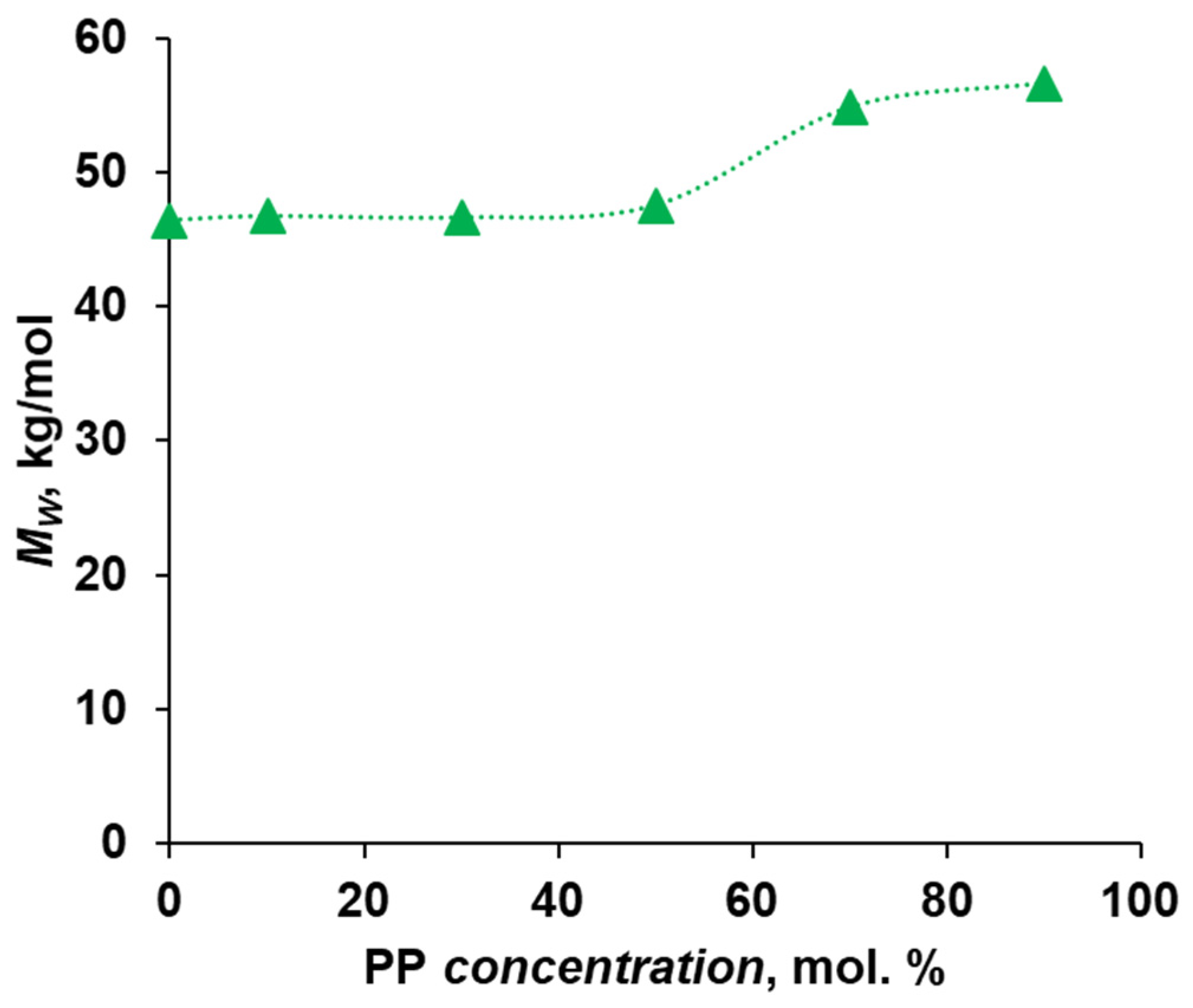
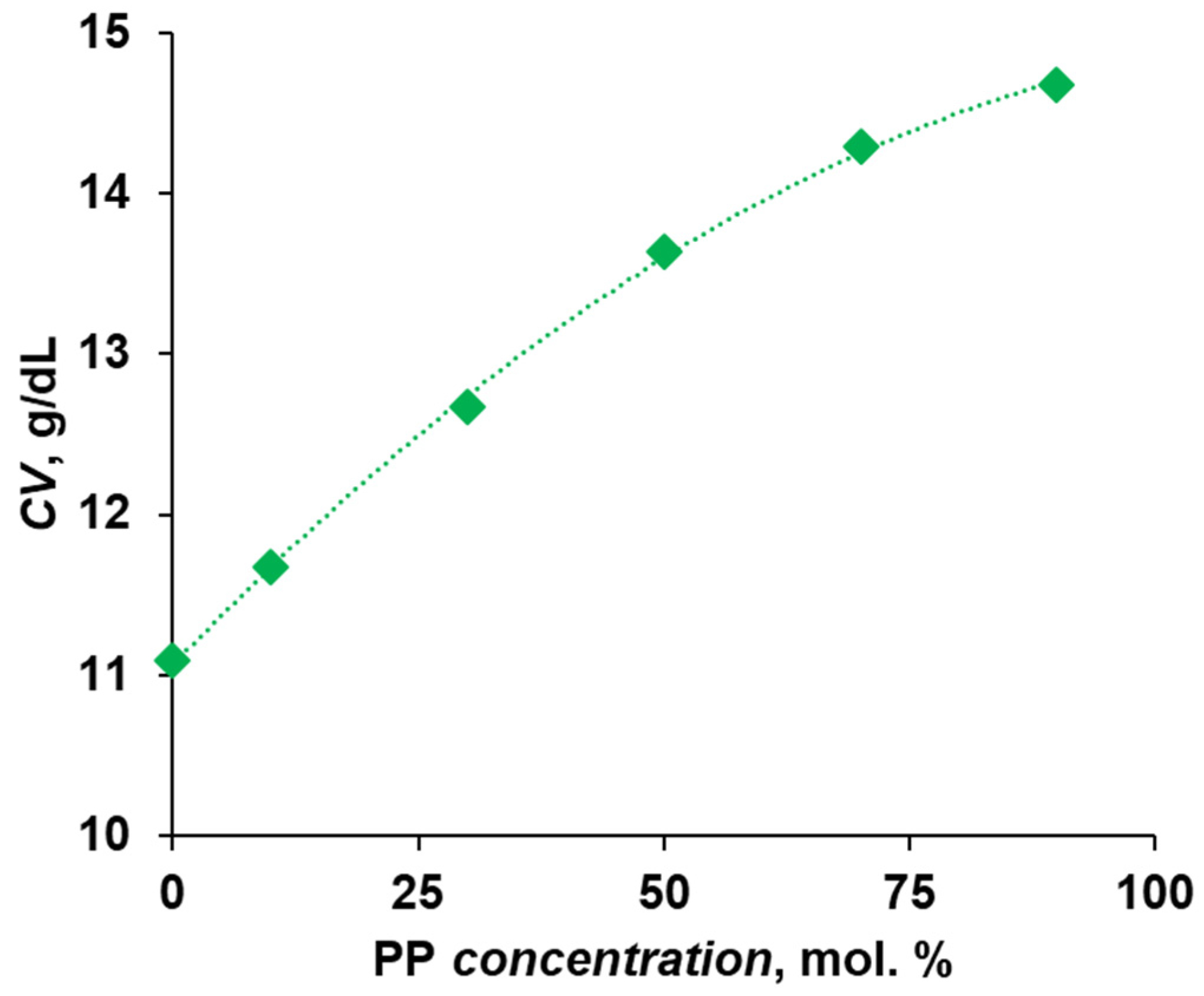
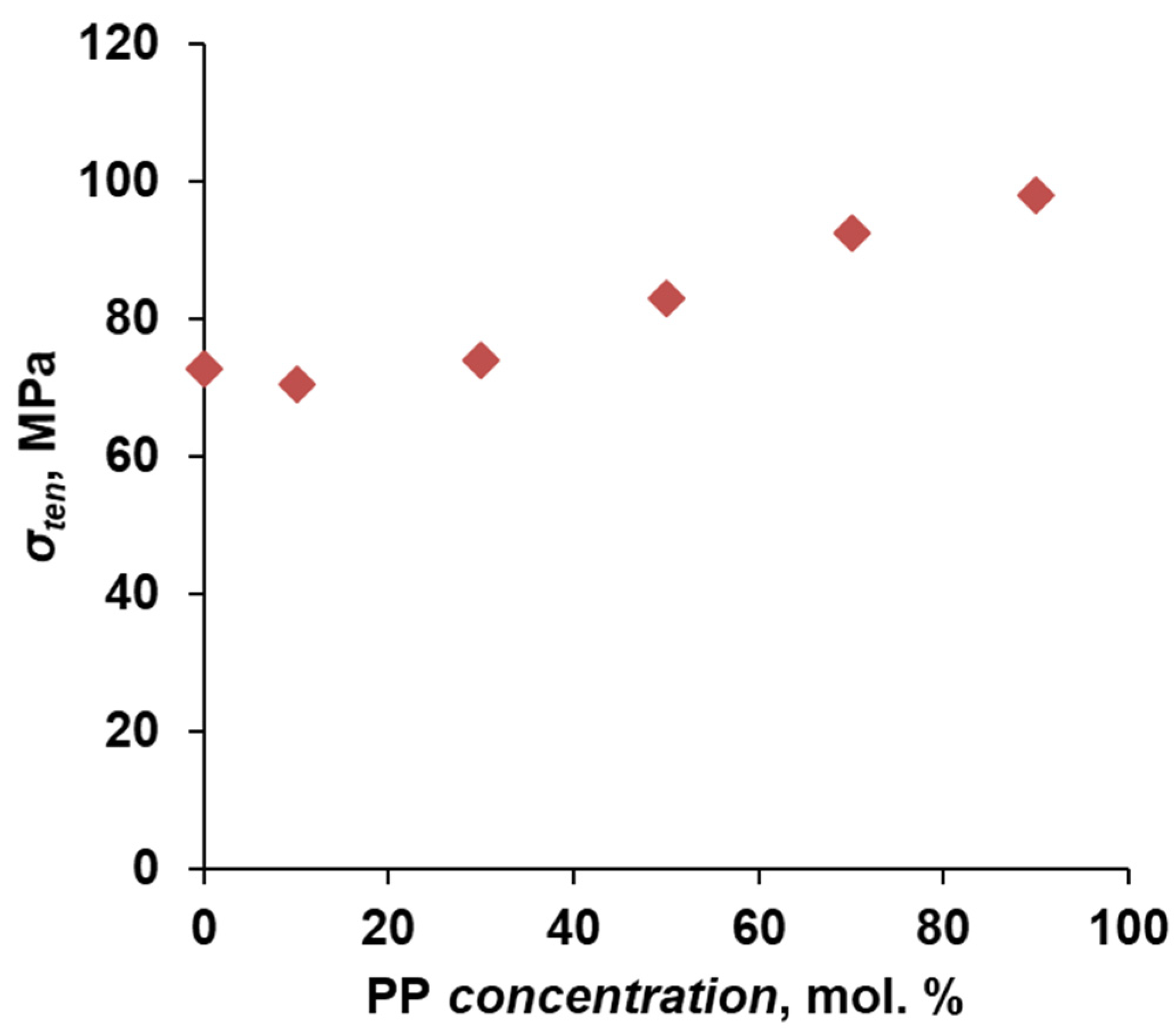


| PP Concentration, mol.% | PP:DHBP:DCDPS * |
|---|---|
| 0 | 0:48.30:51.70 |
| 10 | 4.83:43.47:51.70 |
| 30 | 14.49:33.81:51.70 |
| 50 | 24.15:24.15:51.70 |
| 70 | 33.81:14.49:51.70 |
| 90 | 43.47:4.83:51.70 |
| PP Concentration, mol.% | Solvent | Additive | Cadd, wt.% |
|---|---|---|---|
| 0 | NMP | - | - |
| DMAc | |||
| DMF | |||
| DMSO | |||
| 50 | NMP | ||
| DMAc | |||
| DMF | |||
| DMSO | |||
| 90 | NMP | ||
| DMAc | |||
| DMF | |||
| DMSO | |||
| 0 | NMP | - | - |
| PEG | 30 | ||
| 10 | - | - | |
| PEG | 30 | ||
| 30 | - | - | |
| PEG | 30 | ||
| 50 | - | - | |
| PEG | 30 | ||
| 70 | - | - | |
| PEG | 30 | ||
| 90 | - | - | |
| PEG | 30 |
| Solvent | PP 0 mol.% | PP 50 mol.% | PP 90 mol.% |
|---|---|---|---|
| NMP | + | + | + |
| DMAc | − | + | +− |
| DMF | −+ | + | +− |
| DMSO | − | + | −+ |
| Polymer | Manufacture | Tensile Strength, MPa | Ref. |
|---|---|---|---|
| PPSU Radel R-5100 | Solvey, Belgium | 73 | [39] |
| PSU Udel-1700 | Solvey, Belgium | 74 | [40] |
| PES Ultrason E6020 | BASF, Germany | 30.8 | [41] |
| PP Concentration, mol. % | SEM | Optical Microscope |
|---|---|---|
| 0 | 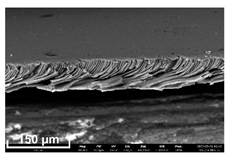 |  |
| 10 | 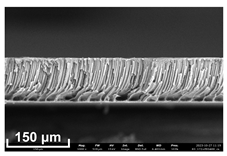 |  |
| 30 |  |  |
| 50 |  | 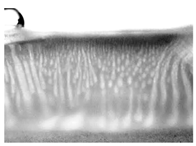 |
| 70 |  |  |
| 90 | 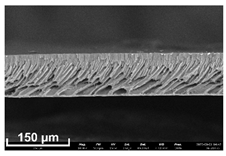 | 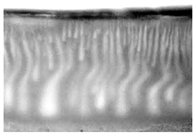 |
Disclaimer/Publisher’s Note: The statements, opinions and data contained in all publications are solely those of the individual author(s) and contributor(s) and not of MDPI and/or the editor(s). MDPI and/or the editor(s) disclaim responsibility for any injury to people or property resulting from any ideas, methods, instructions or products referred to in the content. |
© 2024 by the authors. Licensee MDPI, Basel, Switzerland. This article is an open access article distributed under the terms and conditions of the Creative Commons Attribution (CC BY) license (https://creativecommons.org/licenses/by/4.0/).
Share and Cite
Raeva, A.; Matveev, D.; Bezrukov, N.; Grushevenko, E.; Zhansitov, A.; Kurdanova, Z.; Shakhmurzova, K.; Anokhina, T.; Khashirova, S.; Borisov, I. Highly Permeable Ultrafiltration Membranes Based on Polyphenylene Sulfone with Cardo Fragments. Polymers 2024, 16, 703. https://doi.org/10.3390/polym16050703
Raeva A, Matveev D, Bezrukov N, Grushevenko E, Zhansitov A, Kurdanova Z, Shakhmurzova K, Anokhina T, Khashirova S, Borisov I. Highly Permeable Ultrafiltration Membranes Based on Polyphenylene Sulfone with Cardo Fragments. Polymers. 2024; 16(5):703. https://doi.org/10.3390/polym16050703
Chicago/Turabian StyleRaeva, Alisa, Dmitry Matveev, Nikolay Bezrukov, Evgenia Grushevenko, Azamat Zhansitov, Zhanna Kurdanova, Kamila Shakhmurzova, Tatyana Anokhina, Svetlana Khashirova, and Ilya Borisov. 2024. "Highly Permeable Ultrafiltration Membranes Based on Polyphenylene Sulfone with Cardo Fragments" Polymers 16, no. 5: 703. https://doi.org/10.3390/polym16050703
APA StyleRaeva, A., Matveev, D., Bezrukov, N., Grushevenko, E., Zhansitov, A., Kurdanova, Z., Shakhmurzova, K., Anokhina, T., Khashirova, S., & Borisov, I. (2024). Highly Permeable Ultrafiltration Membranes Based on Polyphenylene Sulfone with Cardo Fragments. Polymers, 16(5), 703. https://doi.org/10.3390/polym16050703









